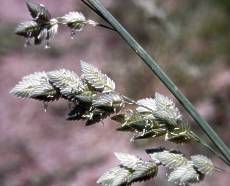Eragrostis superba
Eragrostis superba Peyr.
Family: Poaceae
Common names: saw-tooth love grass, flat-seed love grass (Eng.); bosluissaadgras (Afr.)
Introduction

The large, flat, attractive spikelets on inflorescences that occur well above the basal tuft of leaves make this one of the easiest Eragrostis species in our region to identify.

Description
Description
Perennial up to 1 m tall, erect or lower culms (stems) bent; inflorescence variable as it is either a contracted (narrow) or open panicle, when open, then branches long and flexuous. The common names are very descriptive of the spikelets which are large, being up to 16 mm long, flat, have jagged edges, green, often flushed purple and when mature, break off as a complete unit. Flowering time is from August to May.
Distribution and habitat
Distribution description
This grass is found from the Free State and Kwazulu-Natal northwards to the Sudan usually on sandy or gravel soils occasionally on clay. Found mainly in disturbed places in the veld and roadsides, also grows on termitaria. It has been introduced to India, Australia and the USA.
Derivation of name and historical aspects
History
Eragrostis comes from the Greek eros meaning love and this possibly refers to the heart-shaped spikelets; agrostis means a grass. The species name superba is the Latin for splendid and is probably descriptive of the spikelets.
Eragrostis is a cosmopolitan genus occurring mainly in the tropics and subtropics with ± 350 species of which about 90 occur in southern Africa.

Uses
Use
E. superba is a palatable grass especially in spring and is fairly drought-resistant and because of this has been cultivated as a pasture in some countries. As it grows in disturbed places, it has been used in erosion control and re-vegetation projects. The attractive inflorescence could be used in flower arranging.
Growing Eragrostis superba
Grow
This grass should grow well in an indigenous or wild corner of a garden. Since it has been used as pasture or for erosion control, seeds should be available commercially. As with most perennial grasses it is advisable to cut the plants short at the end of the growing season.

References
- Gibbs Russell, G.E., Watson, L., Koekemoer, M., Smook, L., Barker, N.P., Anderson, H.M. & Dallwitz, M.J. 1991. Grasses of southern Africa. Memoirs of the Botanical Survey of South Africa No. 58.
- Chippindall, L.K.A. & Crook, A.O. 1976. 240 grasses of southern Africa, part 175. Collins, Salisbury.
- Van Oudtshoorn, F. 1999. A guide to the grasses of southern Africa. Briza Publications, Pretoria.
Credits
Lyn Fish
National Herbarium,
Pretoria
Plant Attributes:
Plant Type: Grass
SA Distribution: Free State, Gauteng, KwaZulu-Natal, Limpopo, Mpumalanga, North West, Northern Cape
Soil type:
Flowering season: Late Summer
PH:
Flower colour: Green
Aspect: Full Sun
Gardening skill: Average
Special Features:
Horticultural zones









Rate this article
Article well written and informative
Rate this plant
Is this an interesting plant?
Login to add your Comment
Back to topNot registered yet? Click here to register.